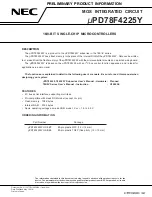CALRAM Operation
MPC561/MPC563 Reference Manual, Rev. 1.2
Freescale Semiconductor
22-5
22.4.1
Reset
Reset configures the CALRAM module and resets some of the bits in the CALRAM registers to their
default reset state. Some register bits are unaffected by reset. See section
22.4.2
One-Cycle Mode
The CALRAM registers and array may be accessed for reads or writes as byte, (aligned) half-word, or
word. This mode is the default mode of operation and, as the name suggests, the access time to the array
and the internal registers for reads and writes is one cycle. Thus the one-cycle mode is used for high
performance although it consumes more power than the two cycle mode.
22.4.2.1
CALRAM Access/Privilege Violations
Each 8-Kbyte CALRAM array can be assigned read-only, data-only, or supervisor-only privilege if data
relocate (DR) bit in the MSR is set. All CALRAM registers are assigned supervisor-only and data-only
privilege. A privilege violation causes an error. See section
Section 22.5.1, “CALRAM Module
Configuration Register (CRAMMCR)
An attempt to access any of the four unimplemented reserved registers (of the 16 register spaces) causes
an error and returns 0’s on the data bus for a read access. If an error condition occurs due to privilege
violation or an attempt to access unimplemented portions of array or register space, then the type of the
error generated depends on whether the access generating the error was initiated by the RCPU core or by
a non-RCPU bus master. If the error causing access was initiated by the RCPU core, a data storage
interrupt (DSI) is generated. If the access was initiated by a non-RCPU bus master, a machine check
exception is generated. Also, a write access that generates an error does not corrupt the data in an array or
a register. Similarly, a read access that generates an error does not drive the data on the L-bus from the
array or the register, instead it drives 0’s. Also, aborted accesses maintain data integrity. Aborted writes do
not corrupt data in register/array, and aborted reads do not drive the requested data on L-bus.
22.4.3
Two-Cycle Mode
In this mode, the CALRAM module takes two cycles to complete an access and consumes less power than
in one-cycle mode.
It follows the normal one-cycle mode operation except that the accesses are completed
one cycle later. This mode is selected by setting the 2CY bit in the CRAMMCR register.
22.4.4
Standby Operation/Keep-Alive Power
The registers and control logic for the CALRAM module are powered by VDD
.
The memory array is also
supplied by VDD during normal operation; however, when the VDD is off, the CALRAM array is backed
up by a switched source (IRAMSTBY) that is also known as standby power.
Summary of Contents for MPC561
Page 84: ...MPC561 MPC563 Reference Manual Rev 1 2 lxxxiv Freescale Semiconductor...
Page 144: ...Signal Descriptions MPC561 MPC563 Reference Manual Rev 1 2 2 46 Freescale Semiconductor...
Page 206: ...Central Processing Unit MPC561 MPC563 Reference Manual Rev 1 2 3 62 Freescale Semiconductor...
Page 302: ...Reset MPC561 MPC563 Reference Manual Rev 1 2 7 14 Freescale Semiconductor...
Page 854: ...Time Processor Unit 3 MPC561 MPC563 Reference Manual Rev 1 2 19 24 Freescale Semiconductor...
Page 968: ...Development Support MPC561 MPC563 Reference Manual Rev 1 2 23 54 Freescale Semiconductor...
Page 1144: ...Internal Memory Map MPC561 MPC563 Reference Manual Rev 1 2 B 34 Freescale Semiconductor...
Page 1212: ...TPU3 ROM Functions MPC561 MPC563 Reference Manual Rev 1 2 D 60 Freescale Semiconductor...
Page 1216: ...Memory Access Timing MPC561 MPC563 Reference Manual Rev 1 2 E 4 Freescale Semiconductor...


















